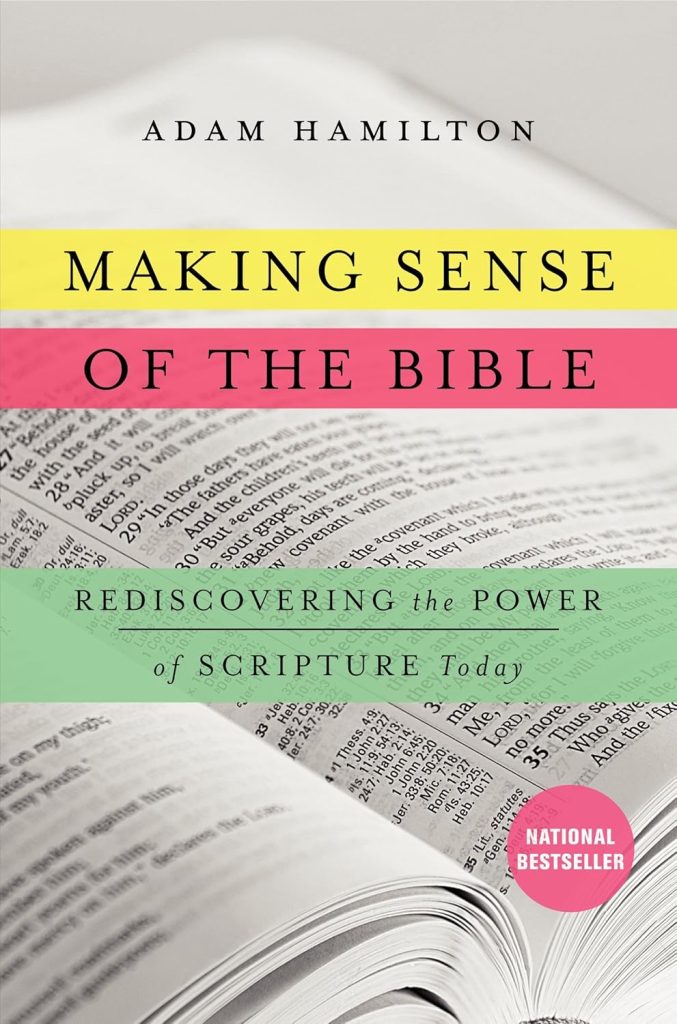by Adam Hamilton
In a discipleship class based on this book, an older adult said: “I wish someone had led this class when I was a high school youth. I almost left the faith because too much of the Bible seemed antithetical to Jesus. If I had learned to read the Bible through Jesus, it would have made more sense.”
This is Adam Hamilton’s goal for this book. Making Sense of the Bible seeks to reveal a unity of scriptural spirit while presenting Jesus as the imperative for interpreting all scripture.
The introduction is titled, “A Disturbing, Wonderful, Perplexing, and Inspiring Book.”It offers Hamilton’s attempt to look honestly at the Bible, knowing it contains each of these elements.
He affirms those with doubts regarding specific elements of scripture. A new believer, a scientist, wonders why many Christians insist the biblical creation stories are literal and fact when they are opposite of the conclusions of modern scientific research.
An attorney is troubled that the Gospels often disagree on the specifics of Jesus’ works. He tells Hamilton, “In a courtroom, when the witnesses disagree like this, I know something is wrong.”
Hamiton suggests one must affirm the legitimacy of such questions while suggesting the answers are found by reading the Bible through Jesus, who is “God in the flesh.”
Hamilton carefully explains “What the Bible is Not.” It is not “the owner’s manual for life,” nor is it a Magic 8 Ball where, after shaking it, you peer into the window on the bottom to find displayed an answer.
The Bible, likewise, is also not a book of “God promises.” While it contains God’s promises, it is not a promise book that leads to temporal satisfaction.
Hamilton takes care to note how the Bible came to be. He affirms the significance of both the Old and New Testaments while suggesting again that Jesus is the litmus test for all truth.
Hamilton suggests the New Testament is best seen as a collection of letters. These letters reveal how people’s lives and their views of faith were changed by meeting Jesus.
Hamilton then asks, “Is the Bible Inspired?” His case for inspiration is exceptional and centers on how Jesus is the ultimate revelation of God, and thus, all scripture finds inspiration through the Christ lens.
Hamilton’s book is divided into two sections: “What Is the Bible?” and the questions that demand answers. Hamilton challenges the inerrantist view of scripture as a low view of the Bible, while a Christ-centered interpretation elevates the Bible to its true and highest nature.
Making Sense of the Bible can be purchased with an associated video that offers material to both support and expand upon the book. Hamilton offers in the video his personal testimony of becoming a Christ-follower, an experience that grew from reading the Bible and cherishing its witness.
He suggests true faith produces a willingness to wrestle with the Bible, and it reminds the reader that Jesus is the object of our faith rather than scripture. For Hamilton, Jesus is the soul of our convictions, so he must be the criteria for interpreting scripture.
This book is the best resource for interpreting the Bible I have found. It offers a deepness of faith while honestly recognizing the problems that can arise if we fail to keep Jesus at the forefront of our efforts toward interpretation.
Review by Tommy McDearis, pastor of Church on Main in Blacksburg, Va.

